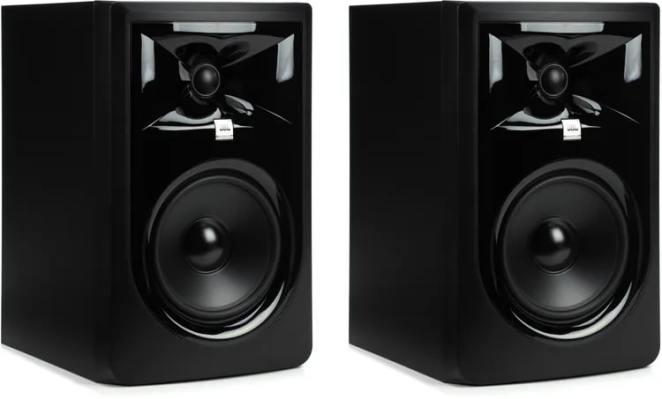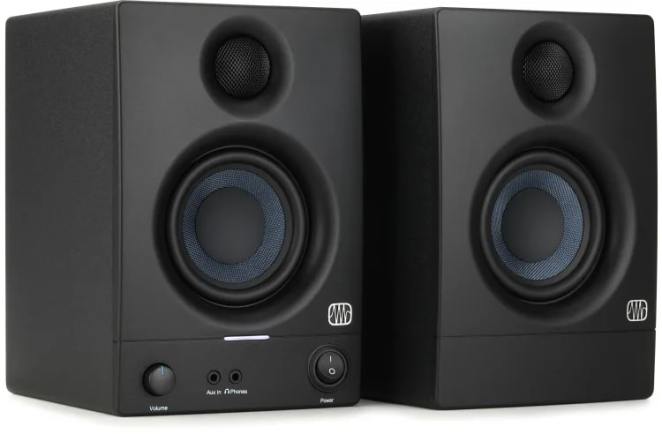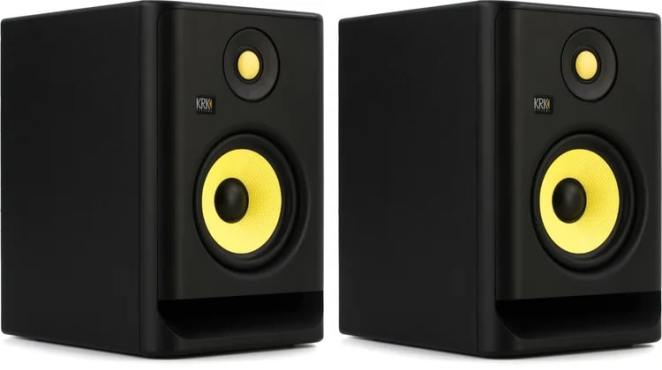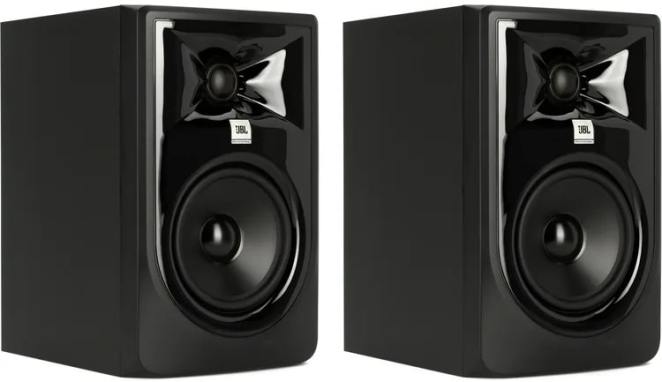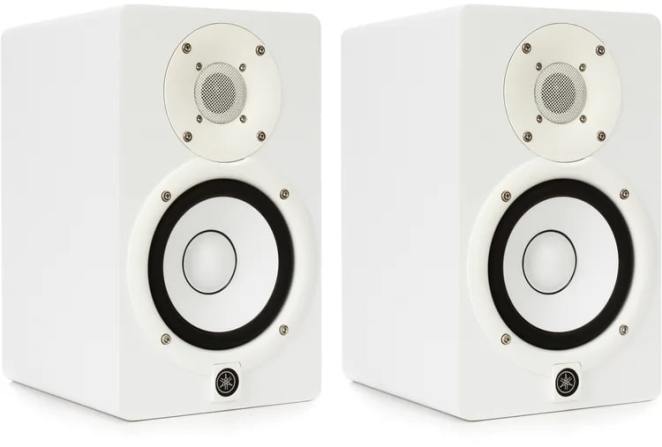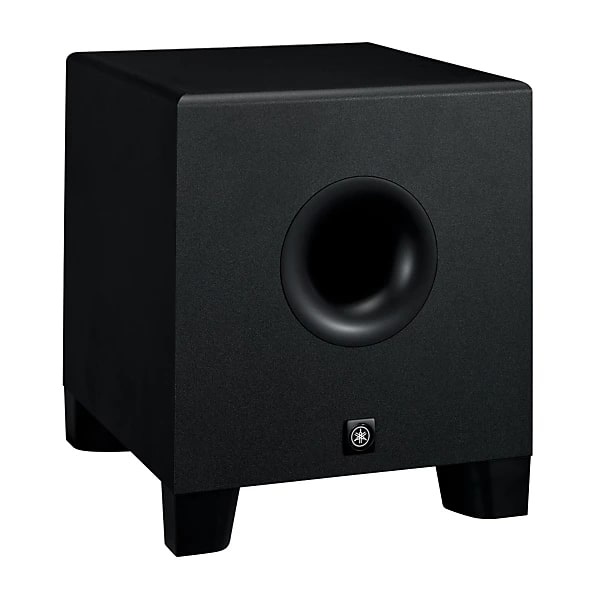When you buy through our links, we may earn an affiliate commission.
Want to elevate the quality of your mixes without breaking the bank?
Then, a good pair of budget studio monitors is exactly what you're looking for, as they'll allow you to hear every detail in your projects without forcing you to spend thousands of dollars.
In this article, we have gathered the best budget studio monitors for everyone, no matter if you're a bedroom producer or an amateur mixing engineer. We also threw in a quick buyer's guide so you know what to look for while shopping for studio speakers.
Our #1 pick is the JBL 306P MkIIs, as they offer top-notch sound, complex EQ controls, and low-volume optimization at an affordable price tag.
The best budget studio monitors for you will help you take your mixes to a whole new level without sacrificing too much space or money. Let's find the right one for you!
Quick Summary of the Best Budget Studio Monitors
- JBL 306P MkII (Best Overall)
- PreSonus Eris 3.5 (Best Studio Monitors for Tight Budgets)
- Kali Audio LP-8 V2 (Best 8-inch Monitors)
- KRK ROKIT 5 G4 (Best for Cutting-Edge Technology)
- JBL 305P MkII (Best Studio Monitors for Bedroom Producers)
- ADAM Audio T5V (Best for Professional Sound)
- Yamaha HS5 (Best for Sleek Design)
- Auratone 5C Super Sound Cubes (Best for Passive Reference)
- Yamaha HS8S (Best Subwoofer)
Best Budget Studio Monitors
Best Overall
SPECS
- Driver size: 6.5 inches
- Frequency response: 47Hz – 20kHz
- Total power: 112 watts
Few brands are as recognizable as JBL when it comes to high-fidelity, cutting-edge audio monitoring. Its top-of-the-line products have always leaned toward the more expensive side of things — but, luckily for us, the JBL 306P MkIIs are here to change that.
These absolute monsters of studio monitors are the perfect nearfield solution for any music producer looking to take their projects to a whole new level. Thanks to their innovative waveguides, widened sweet spots, and cutting-edge transducers, the JBL 306P MkIIs provide unmatched sound quality at an affordable price.
And that's not to mention other perks such as low-volume optimization, environmental EQ compensation, and high-frequency trim switch. All in all, the JBL 306P MkIIs are pretty much the ideal solution for anyone needing to not only monitor their music correctly but also enjoy it.
Best Budget Pick
SPECS
- Driver size: 3.5 inches
- Frequency response: 80Hz – 20kHz
- Total power: 50 watts
Now, we know that even the budget options can be rather expensive when looking at studio monitors. The PreSonus Eris 3.5s are pretty much the only exception to this, offering balanced sound at an astonishingly low price point. If you're just starting out, or you're handling a very tight budget, you just can't go wrong with these ones.
Packing a more-than-respectable 50 watts of power, the PreSonus Eris 3.5s offer crystal-clear playback with versatile connectivity for each and every usage scenario. The rear-panel tuning knobs allow for accurate sound reproduction even in a poorly treated room, and their compact format will fit into any desk.
The composite transducers will open up a world of critical listening even if you're not an experienced producer. In fact, many non-musicians choose the PreSonus Eris 3.5s just for the listening pleasure of having accurate audio right in the comfort of their desk!
Best 8-Inch Monitors
SPECS
- Driver size: 8 inches
- Frequency response: 43Hz – 21kHz
- Total power: 100 watts
Not everyone can fit some gigantic powerhouses on their desks — but, for those who can, the Kali Audio LP-8 V2s are the perfect option. Designed to deliver top-notch low mid-range frequencies and transparent high-ends, these absolute monster monitor speakers are all you need to take your studio to a whole new level.
But the incredibly accurate bass response of the Kali Audio LP-8 V2s isn't the only thing worth mentioning. These massive monitors offer a near-perfect flat frequency response and a top-notch stereo image that will elevate your mixes out of this world.
On the back of the Kali Audio LP-8 V2s you'll find eight diagrams that will guide you when it comes to boundary EQ. Through three simple switches, the Kali Audio team has created enough profiles to fit pretty much any room's acoustics!
Best for Cutting-Edge Tech
SPECS
- Driver size: 5 inches
- Frequency response: 43Hz – 40kHz
- Total power: 55 watts
The KRK ROKIT 5 G4s are a state-of-the-art option fit for producers and music-makers who only want the best of the best. High-grade materials, mobile connectivity, and cutting-edge technology are the name of the game with these studio monitors — and that's not to mention the fantastic sound quality.
Maybe the most important aspect of the KRK ROKIT 5 G4s is the top-notch DSP that aims to maximize any room's acoustics. Forget about messing around with acoustic treatment — just dial in your EQ settings from the back of the monitors and check out the real-time spectral analysis on your mobile device.
The speaker cone of each monitor is made out of Kevlar, providing low-distortion sound across all frequencies. Furthermore, the built-in brick wall limiter will automatically engage if you ever max out the amp, ensuring not only a balanced sound at all volumes but also ear protection.
Best for Bedroom Producers
SPECS
- Driver size: 5 inches
- Frequency response: 49Hz – 20kHz
- Total power: 82 watts
We already placed the 6.5-inch JBLs at the top of our list, but not everyone can fit such large monitors in their workspace. And that's where the JBL 305P MkIIs really shine, providing pretty much the same benefits but at a lower price and a more compact format.
Everything remains pretty much the same — boundary EQ possibilities, innovative waveguides, and low-frequency accuracy are all included in the JBL 305P MkIIs. But, unlike their bigger brothers, the 305Ps will fit into any desk, making them a perfect choice for bedroom producers.
Also worth mentioning is that the JBL 305P MkIIs are shielded for safe placement near sensitive equipment. So you can forget about unwanted distortion and interference when placing your monitor speakers near your music-making station!
Best for Pro Sound
SPECS
- Driver size: 5 inches
- Frequency response: 45Hz – 25kHz
- Total power: 70 watts
If you're looking for professional studio monitors on a budget, then the ADAM Audio T5Vs are, by far, your best bet. These sober-looking speakers may not be too flashy to the eye — but boy do they pack a punch on the inside.
Thanks to years of in-house research, the ADAM Audio T5Vs take advantage of cutting-edge technology when it comes to their low-frequency drivers and tweeters. The low-mass state-of-the-art polypropylene cones allow for transparent yet impactful sound across a wide frequency range.
Furthermore, the materials inside the monitor speakers are nothing short of amazing — from rare-earth magnets to piston-like diaphragms, every component contributes to that almost-perfect flat response. If you're looking to get the exceptional sound quality of professional studios, look no further than the ADAM Audio T5Vs.
Best for Sleek Design
SPECS
- Driver size: 5 inches
- Frequency response: 74Hz – 24kHz
- Total power: 70 watts
Monitors are a big part of any studio, so looks shouldn't be... well, overlooked. The Yamaha HS5s understand that perfectly, offering a sleek, futuristic design that's available in both black and white. Forget about blocky speakers ruining the aesthetic of your home studio — these beautiful monitors will fit right in.
But looks aren't everything Yamaha has to offer: the HS5s innovate by offering bi-amplified drivers that deliver almost no coloration to the sound. Plus, the circuits inside are full of extra-large magnets that provide smooth audio all around. Put plain and simple, the Yamaha HS5s just sound good.
And, of course, the room controls are there to make sure you don't have to acoustically prepare your studio before buying these beautiful monsters. Add to that a handy high-trim switch and you'll be ready to go in pretty much any environment.
Best for Passive Reference
SPECS
- Driver size: 4.5 inches
- Frequency response: 75Hz – 15kHz
- Total power: 50 watts
Not everything in the studio monitors world has to do with plain frequency response, gigantic speakers, and dozens of cables. Sometimes, you just need a good pair of modest reference monitors to hear your mixes on a second set of speakers — and that's where the Auratone 5C Super Sound Cubes come in.
These stylish, vintage-looking cubes are the perfect addition for any home studio enthusiast who already has all the basics covered, including a primary set of monitors. Just throw the Auratone 5C Super Sound Cubes somewhere near your main speakers and enjoy the pleasure of A/B comparison.
And the best part of it all? The Auratone 5C Super Sound Cubes are completely passive speakers, meaning they don't need any power or extra cables besides the audio input.
Best Subwoofer
SPECS
- Driver size: 8 inches
- Frequency response: 22Hz – 150Hz
- Total power: 150 watts
For those producers who love bass-heavy productions or music genres, a pair of studio monitors may just not cut it. To really feel the bass, you need a high-quality subwoofer — and the Yamaha HS8S fits the bill perfectly. Coming in at almost 30 pounds, this absolute bass powerhouse is all you'll ever need.
The Yamaha HS8S can go really deep when it comes to the low end, as it's capable of producing crystal-clear bass response as low as 22Hz. This will allow you to hear every bit of that nasty low-end mud that most producers often miss.
And when the time comes for your ears to relax a bit, the Yamaha HS8S comes equipped with three different EQ controls for you to mess around with. These include a low-cut switch, a low-cut knob, and a high-cut knob. If you feel like you're missing a bit from your primary monitors, the Yamaha HS8S will be sure to deliver.
Budget Studio Monitors Buyer's Guide
Frequency Range
Frequency range should be the first aspect you should take into account whenever you're shopping for studio monitors (or any other type of speakers). In short, this refers to the overall sonic range of the monitors — meaning how high and how low they can go.
To give you a basic idea, basses and kicks live in the 60–250Hz range, guitars in the 250–1000Hz, and vocals in the 1000–4000Hz. Of course, all of this can vary — but it's important to get the idea that music mostly lives within the 50–10000Hz range.
So then, why do studio monitors go much higher and lower than that? Well, the human hearing range comprises from 20Hz to 20000Hz, and anything that's on the edges of this 50–10000Hz range will also be heard. This can mean presence, sub-bass, and brilliance, but it also can mean unwanted mud in barely audible zones.
As such, it's essential to shop for studio monitors that can cover as much of this spectrum as possible. You'll also notice that some monitors go way over the 20000Hz limit — although the difference may be subtle, this helps give your highs a more transparent sound.
Passive vs Active
Another thing worth keeping an eye out for is whether the monitors are active or passive. While one type isn't necessarily better than the other, knowing the difference can help you avoid a crucial mistake — that is, plugging your new speakers and not hearing anything!
Passive speakers, on one hand, are designed for people who already have an amplifier in their setup. This can mean either an external amp, a digital-to-analog converter, or an audio interface. If you try to plug in a signal that's not amplified, the resulting sound will barely be audible.
Active speakers, instead, cover everything from amplifier to crossover. As such, they're the best option for almost anyone, as they can also receive externally-amplified signals.
So, why would you even get passive speakers? The reasons are simple: they're easier to mount and upgrade, and are generally a bit cheaper than active ones. But still, most people will prefer active monitors in pretty much any scenario.
Total Power
You'll often find that studio monitors display their total power as one of their main perks. As you can imagine, this refers to the volume they can produce across the whole sound spectrum. However, its effects go way beyond that!
Higher-wattage studio monitors will allow for more headroom and a bigger dynamic range, which in turn will result in better-sounding transients. While this may not seem like a huge deal, you'll greatly appreciate the difference whenever you're dealing with compressors and other dynamic processors.
But, as with all things in music production, there aren't any hard rules regarding exactly how many watts you should get. As a general guideline, try to get as many as you can — but don't lose your head if your speakers aren't the most powerful on the market!
Room EQing
Last but not least, you should also keep in mind the built-in EQ capabilities of the monitors you're looking at. Now, this doesn't exactly refer to the same EQ possibilities you get in your DAW, but to a specific set of knobs that will allow you to bypass your room's acoustics.
As you may already know, the placement of your speakers makes a big difference in how you hear your music. But let's be real here — not everyone has the ideal setup in their studio, and that's where built-in EQs come in handy. They will allow you to fine-tune your sound to avoid nasty reflections, phase issues, and the overall frequency response in your room.
As a general rule, you should buy studio monitors that strike a balance between the amount of controls and simplicity. Of course, having dozens of knobs and switches will give you the most possibilities to correct the sound — but what good are they if you get overwhelmed and end up not using them?
Frequently Asked Questions (FAQs)
Are cheap studio monitors worth it?
As with all things related to music production, more expensive doesn't necessarily mean better! A good pair of budget studio monitors can last you for decades while also providing excellent sound and a transparent overall frequency response.
Yet, as you probably already know, shopping on a budget requires a bit more research than usual. But as long as you're aware of everything we mentioned in the buyer's guide above, rest assured you'll find the best budget studio monitors you can get!
Do I need 1 or 2 studio monitors?
For most people, getting a pair of studio monitors is undoubtedly the correct choice. This will allow you to hear a transparent stereo image, while getting a single speaker will only let you hear your mixes in mono!
But that doesn't mean that there aren't any scenarios where only one studio monitor would be useful. Some people may want a single speaker for an alternative mono reference to their primary set of speakers, while others may want a single monitor to reinforce the center area in their current stereo setup.
What monitor size is best for home studios?
Well, when it comes to home recording, driver size isn't the most important thing. The answer is pretty simple: it depends on the size of your room. Small-room setups may allow you to use drivers as tiny as 3.5 inches, while normal- or bigger-sized rooms may ask for anything above that.
As a general rule, keep in mind that smaller monitors will be more accurate in small spaces. But don't lose your mind over it! Just try to get monitors that fit your desk and let you work comfortably without overwhelming you.
Is it OK to leave studio monitors on all the time?
Well, the technically correct answer would be no. Monitors that are permanently left on will have a slight chance of coming across electrical interference that could damage the components in the long run. And that's not to mention that leaving unnecessary electrical stuff on damages the environment!
However, when it comes down to the real thing, studio monitors use such small amounts of power that the chance of something going wrong is close to zero. If you can, turn off your monitors whenever you're done using them for the day — but don't worry too much if you forget to do so from time to time!
Verdict
A good pair of studio monitors is a key part of any studio, as they allow producers and mixers to correctly hear everything that's going on in their projects. To find the right one for you, we recommend first trying to define how much frequency range you need covered (spoiler: this will usually be as much as possible).
Then, try to determine whether you're looking for active or passive speakers, and how much power you need from them. And, last but not least, try to take a look at the EQ capabilities of that specific set of monitors, as this will allow you to correct any acoustic-related problems in your room! Getting a quality pair of studio monitor stands is a must as the stands will provide little to no vibration interference as well as let you adjust the height of the monitors.
If you don't want to spend hours on end looking for the perfect studio monitors for you, we recommend you get our favorite pick: the JBL 306P MkIIs. If you're on a very tight budget, however, you may want to opt for the PreSonus Eris 3.5s instead.
